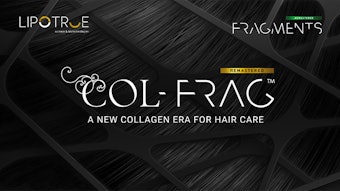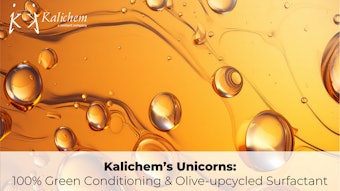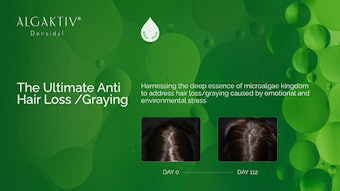Conventional daily use hair care products are predominantly based on relatively large molecules such as surfactants, polymers and oils. However, the size of these molecules suggests a limited ability for penetration, and their efficacy is therefore restricted solely to the hair surface. In short, conditioning and styling ingredients are deposited at the surface and subsequently removed by the surfactants in shampoos. However, there may be a next generation of products that can be developed and will manipulate the internal properties of hair—and presumably, these products must revolve around smaller molecules that are better able to penetrate.
This article describes results from three test methods that measure properties relating specifically to the internal structure of hair. In each case, the treatment of hair with glycolic acid (see Figure 1) brings about significant changes in the bulk properties of hair. Note that unless otherwise specified, the work described here was performed using 5% solutions of a commercially-available cosmetic grade glycolic acida.
Tensile Properties
The remarkable strength of human hair is a consequence of its highly complex structure; accordingly, its mechanical properties can serve as a probe to investigate structural changes. For example, the decrease in tensile strength that accompanies chemical treatments, i.e., perms, coloring or bleaching, indicates the hair has been permanently altered via a depletion in strength-supporting cystine bonds within its internal cortical structure. It is, therefore, well-recognized that the tensile properties are dominated by the internal hair structure, with practically no contribution from the outer cuticle layer.2
While these chemical treatments decrease the break force of individual fibers, their dry-state stiffness, i.e., Young’s modulus, often increases significantly. This is perhaps counterintuitive, as it would seem that a reduction in internal bonding would lead to a general decrease of all tensile properties. However, this occurrence is consistently seen after such treatments, as well as after UV exposure, and this increase in stiffness likely represents one contributor to the coarse, dry feel of damaged hair.
Stress-strain curves: The tensile properties of virgin Caucasian hair treated with a 5% glycolic acid solution were compared with an untreated control sample. Experiments were performed by generating a series of stress-strain curves for individual fibers using an automated tensile testerb. The details of such experiments have been described previously.3 In each instance, 50 replicate fibers were tested to provide the appropriate statistical rigor.
Results: Figure 2 shows that treatment with glycolic acid significantly decreased the Young’s modulus of hair. Moreover, this behavior could be reversed by dialyzing the hair in deionized water (data not shown). This indicates that treatment with glycolic acid did not permanently alter the hair structure, but instead likely induced temporary plasticization, i.e., softening.
Discussion: These results draw an analogy to the effects of water on hair. The presence of water leads to the solvation of secondary structural bonds, including hydrogen bonds and salt bridges, within the hair; consequently, the mechanical properties decrease with increasing water content. However, the amount of water in hair is strongly tied to the relative humidity of the environment, and so the properties of hair are at the mercy of the elements.2, 4
Glycolic acid is also a small, hydrogen-bonding molecule that can penetrate into hair and apparently bring about a comparable effect. However, unlike water, glycolic acid is not volatile and thus presents a means of manipulating the stiffness of hair in a semi-permanent manner. Perhaps most noteworthy is the ability to reverse the previously described fiber stiffness.
Water Content
In addition to breakage, consumers often express concerns about hair “drying out.” Consequently, they demand treatments that purport to “replenish water content” by means of “hydration” or “moisturization.” However, as already mentioned, the water content of hair is dominated by the relative humidity of the environment and is only slightly influenced by other factors, such as hair quality.4
Furthermore, sensory testing performed by Davis and Stofel5 has convincingly demonstrated that consumers overwhelmingly prefer the feel and properties of hair that is equilibrated at low humidity, i.e., that possesses low water content, over that maintained at elevated humidity. It has also been shown that the tendency for hair breakage is dramatically increased at high humidity;6 i.e., at elevated water content. In short, despite consumer demands, it is evident that more desirable hair properties are obtained when the water content of hair is minimized.
A representation of the equilibrium water content of hair, as a function of progressively higher relative humidity, is termed an adsorption isotherm; a similar study under decreasing humidity conditions produces a desorption isotherm. These two curves take somewhat different paths because adsorption occurs on a non-swollen substrate while desorption arises from a swollen state where more adsorption sites are exposed. Therefore, a hysteresis loop occurs between the adsorption and desorption curves for water and hair.4 Such experiments are performed using a gravimetric approach on commercially available equipment termed Dynamic Vapor Sorption (DVS).4
DVS and results: As part of the present study, the adsorption and desorption curves for hair treated with a 5% glycolic acid solution were compared to an untreated control. All experiments were performed using a DVS measurement systemc. In both instances, testing involved approximately 30 mg of hair that was allowed to equilibrate at a series of relative humidities for eight hours at each condition. Figure 3 shows how treatment with glycolic acid produced a significant reduction in the water content of hair.
Discussion: There is precedent in the scientific literature for treatments that can reduce the water content of hair and wool,7, 8 albeit not necessarily using cosmetically-acceptable reagents. In this prior work, it was theorized that the effect was due to extraneous molecules blocking water adsorption sites within the hair by simple steric means, as opposed to any actual permanent alteration in hair structure or chemistry. Once again, the present studies show that this behavior can be reversed by dialysis in de-ionized water, which lends credence to this adsorption theory.
Thermal Denaturation Temperature of Hair
The major structuring component of hair is α-helical keratin protein, which resides within micro-fibular assemblies within the cortex. This conformation represents the most stable structure for the protein under normal conditions; but at elevated temperatures, the protein will thermally denature, and the preferred orientation becomes a β sheet structure.9 This transition can be observed by performing differential scanning calorimetry (DSC) experiments.
DSC experiments: DSC experiments involve heating a hair sample at a prescribed rate to determine deviations from the baseline, which are indicative of enthalpic events. Wortmann10 performed these experiments on wet hair sealed in high pressure DSC pans. Under these conditions, healthy hair yields a denaturing temperature of around 155°C (see Figure 4), but this value will decrease as the hair becomes more damaged. Accordingly, these measurements are often used as one way of quantifying hair damage.
Results and discussion: As part of this work, the denaturing temperature of hair previously soaked in a 5% glycolic acid solution was compared to untreated hair. Results consistently showed a dramatic increase in this transition temperature that approximated a 10°C shift.
Radiolabeled Deposition
As noted, the focus of this article is the ability for glycolic acid to penetrate into hair and alter the bulk properties of fibers. Each of the property changes described specifically relates to the internal structure of hair and, therefore, provides ample indirect evidence that penetration occurs. Nonetheless, radiolabeling studies also were performed to gain first-hand evidence of glycolic acid being present within the hair shaft.
For this work, radiolabeled [14C]-glycolic acid was procuredd, and hair was treated with a 1% solution before being subjected to micro-autoradiography, whereby thin cross-sections of the hair were examined by microscopy using photographic film sensitive to the radiolabel. The resulting images demonstrate the penetration of glycolic acid inside the hair fibers (see Figure 5).
Conclusions
Hair care formulators are under constant pressure to deliver improved and/or novel benefits to hair. However, the current pallet of ingredients available is restricted to providing functionality only at the hair surface. It is not uncommon to hear conjecture pertaining to cosmetic ingredients penetrating the hair, but in many cases, simple logic is sufficient to suggest that sizable molecules will diffuse extremely slowly, if at all. Indeed, preliminary results are suggesting that even relatively small molecules can still take considerable time to penetrate.11
A reasonable analogy would involve the discipline of liquid chromatography, whereby a mobile phase readily traverses a stationary phase while dissolved materials progress at different speeds, depending on their size and interaction with the column. Accordingly, it is evident why water may rapidly penetrate into hair while dissolved species take somewhat longer. The small size of glycolic acid seemingly is a principal factor allowing rapid penetration into the hair. Moreover, once inside the bulk structure, the material produces changes that are not attained using existing ingredients.
It is widely recognized that the tensile properties of hair are dictated by the inner cortex structure, with essentially no contribution from the outer cuticle layers. Therefore, an ability to alter tensile parameters is evidence of this inner structure being manipulated. This provides a means by which the stiffness of hair fibers can be finessed; perhaps with the specific objective of countering the increased stiffness associated with hair damage.
Likewise, it is known that adsorbed water resides within a specific portion of the cortex that consists of an amorphous keratin associated protein (KAP) matrix. So again, the ability to alter this property is an indication of glycolic acid penetrating and being retained within the hair. Finally, the protein transition temperatures detected in DSC experiments are associated with a different portion of the cortical structure, known as the intermediate filaments (IFs). Here again, treatment with glycolic acid was able to reverse a change in the property of hair that is typically associated with damage. “Heat protection” is currently a hot topic in the hair care world, so that the ability of a product to raise the thermal denaturation temperature of hair by up to 10°C could be a means of attaining this end goal.
In summary, glycolic acid has the potential to transform the hair care category in a manner comparable to its effect on skin care 40 years ago. The work shown here suggests the potential for a new generation of products developed to manipulate the internal properties of hair. Glycolic acid is indeed able to bring about changes to the innermost structure of hair and as such, it presents the formulation chemist with a means to manipulate hair in ways that have not previously been possible.
References
- B Green, After 30 years …. The future of hydroxacids, J Cosmet Derm 4, 44-45 (2005)
- RR Wickett, Mechanical properties of hair, in Practical Modern Hair Science, T Evans and RR Wickett, eds, Allured Business Media, Carol Stream, IL USA (2012)
- TA Evans, Measuring the strength of hair, part 1–Stress-strain curves, Cosm & Toil 128(8) 590-594 (2013)
- TA Evans, The adsorption properties of hair, in Practical Modern Hair Science, T Evans and RR Wickett, eds, Allured Business Media, Carol Stream, IL USA (2012)
- MG Davis and S Stofel, Consumer perception versus single and bulk fiber technical measurements, Proc 16th International Hair Science Symposium, Weimer, Germany (2009)
- TA Evans, Fatigue testing of hair–A statistical approach to hair breakage, J Cosmet Sci 60, 599-616 (2009)
- IC Watt and JD Leeder, Effect of chemical modifications on keratin and water isotherm, Trans Farad Soc 60 1335 (1964)
- MM Breuer, Binding of phenols by hair, parts I, II and III, J Phys Chem 68 2067-2084 (1964)
- C Popescu, Hair damage, in Practical Modern Hair Science, T Evans and RR Wickett, eds, Allured Business Media, Carol Stream, IL USA (2012)
- FJ Wortmann, C Springob and G Sendelbach, Investigations of cosmetically treated hair by differential scanning calorimetry in water, J Cosmet Sci 53 219-228 (2002)
- TA Evans, Manipulating the bulk properties of hair, Proc of the Society of Cosmetic Chemists Annual Scientific Seminar, Las Vegas, NV (Jun 2011)










